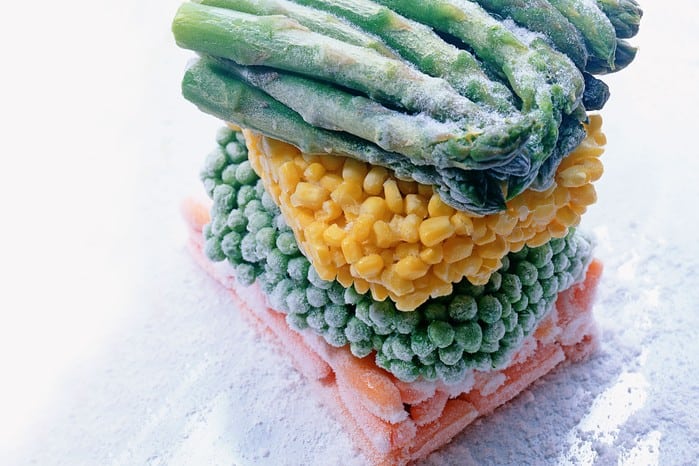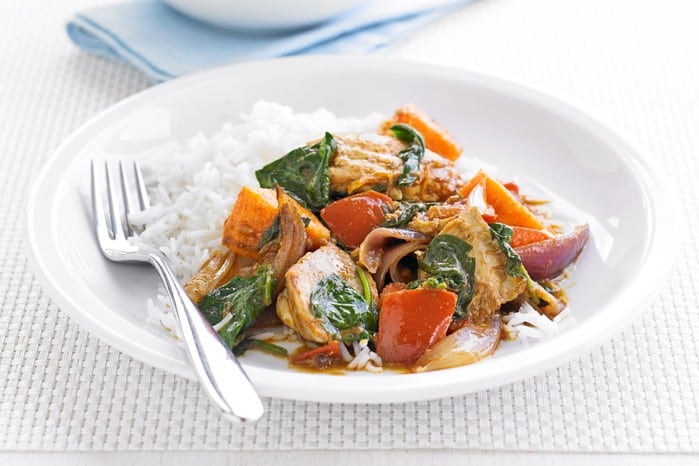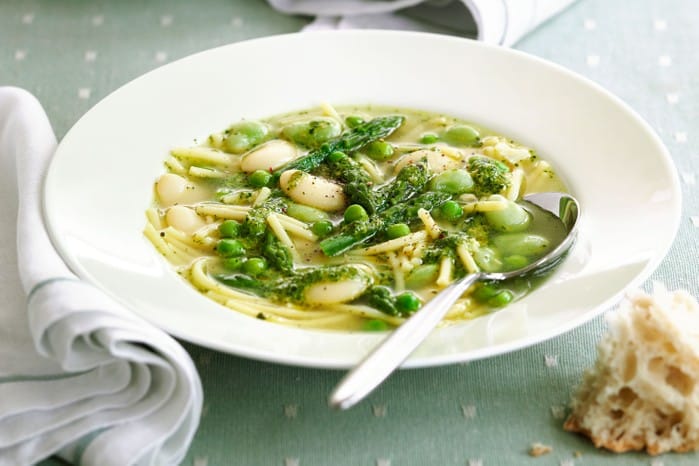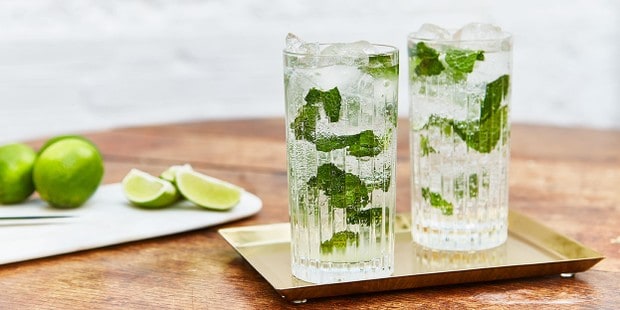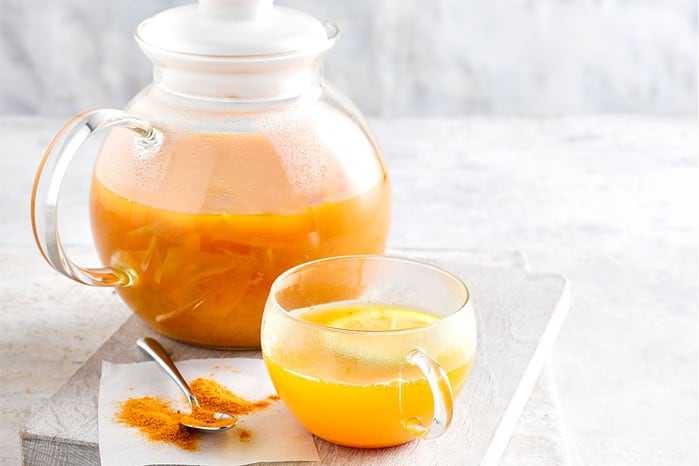How to freeze carrots
Raw carrots go strangely spongy when frozen and defrosted – the water in their cells expands, which bursts the cells. Either chop the carrots finely and freeze them raw – once you’ve fried them you won’t notice the texture – or chop, cut or baton them, cook until al dente, then freeze in batches. If you freeze the pieces flat on a tray you can tip them into a bag when hard and they’ll separate easily when you come to use them.
Check out our how-to guide for more information on freezing carrots.
How to freeze broccoli
Cut the broccoli into florets and cook until al dente, spread the cold florets on a tray and freeze. Once hard, tip them into a freezer bag.
For more on freezing broccoli, read our guide on how to freeze broccoli.
How to freeze potatoes
Raw potatoes don’t freeze well for the same reason as carrots. Chop, slice, chip or chunk them, cook until al dente and freeze in batches, or mash them and freeze in portions. Freeze the pieces flat on a tray and tip into a freezer bag when hard to stop them clumping together. You can toss them in butter, garlic butter or oil and spices before you freeze, then roast from frozen.
For more on freezing potatoes, read our guide on how to freeze potatoes.
How to freeze asparagus
Prep your asparagus by washing it thoroughly and trimming off any woody stems. Then blanch in boiling water for 2-4 minutes, depending on the size of the stalks. Transfer the asparagus using a slotted spoon into a bowl of icy water. Once drained and patted dry, lay on a tray and freeze before transferring to a freezer bag. Alternatively, roast the asparagus for 10-15 minutes after preparing before following the same freezer steps.
For more on freezing asparagus, read our guide on how to freeze asparagus.

How to freeze courgette
Cut your courgette into thick rounds or batons. Then blanch following the same method as with the asparagus, however, only for 1 minute. Alternatively, freeze from roasted. Drizzle your courgette with olive oil and arrange on a baking tray. Roast for 15-20 minutes before leaving to cool, transferring to another tray and freezing before popping the frozen rounds into a freezer bag.
For more on freezing courgette, read our guide on how to freeze courgette.
How to freeze mushrooms
Scrub your mushrooms to remove any dirt, then slice or leave whole. Put the mushrooms in a steam basket and place them above some water with a teaspoon of lemon juice. Bring the mixture to boil and steam the mushrooms for 2-4 minutes, depending on their size. Plunge the mushrooms into icy water. Once drained and patted dry, lay on a tray and freeze before transferring to a freezer bag. Alternatively, gently fry the mushrooms with a small knob of butter before freezing using the same method.
For more on freezing mushrooms, read our guide on how to freeze mushrooms.
How to freeze cauliflower
Prep your cauliflower by washing it and cutting it into equal-sized florets. Put the cauliflower in boiling water and blanch for 2 minutes. Remove the cauliflower with a slotted spoon and place it into icy water before patting it dry and freezing on a tray. After it’s frozen, transfer to a resealable freezer bag.
For more on freezing cauliflower, read our guide on how to freeze cauliflower.
How to freeze runner beans
Take 200g fresh runner beans and peel away any stringy edges. Chop the beans into 2-3cm chunks or slice lengthways. Boil in a pan for 3 minutes before transferring to a bowl of icy water. After they have cooled, place the beans on a tray and freeze. Then transfer to a resealable freezer bag.
For more on freezing runner beans, read our guide on how to freeze runner beans.
How to freeze rhubarb
Rhubarb can be frozen in many ways. The easiest method would be to freeze from raw. Trim the rhubarb of stringy bits and cut them into short lengths. Freeze on a baking tray and then transfer to a resealable freezer bag. Alternatively, you could blanch your rhubarb in boiling water for a minute before transferring it to icy water and continuing with the same freezing method. Other methods include roasting your rhubarb first for 15 minutes or stewing it.
For more on freezing rhubarb, read our guide on how to freeze rhubarb.
Can you freeze lettuce?
No, we would not recommend freezing lettuce.
How to freeze onions
Chop or slice the onions and freeze them raw on trays, once hard, tip them into a freezer bag so you can use them in portions. You can also fry onions to freeze in batches, if you like.
Make your own sofrito
Finely chop equal quantities of raw carrot, celery and onion and mix them together. Freeze flat on a tray and then tip into a freezer bag. A few scoops make a good base for lots of Mediterranean-style recipes.

How to freeze fruit
How to freeze strawberries
Prep the strawberries by washing them in cold water, then drying them with kitchen paper. Cut and discard the stems, then freeze whole or cut to the desired size. Lay the prepared strawberries on a tray and freeze. Once frozen, transfer to a resealable freezer bag.
For more on freezing strawberries, read our guide on how to freeze strawberries.
How to freeze bananas
Peel your bananas and pop them onto a tray whole or in slices. Once frozen, transfer to a resealable freezer bag. To freeze brown bananas, we recommend mashing them and portioning them into separate resealable bags labelled with the quantity.
For more on freezing bananas, read our guide on how to freeze bananas.
How to freeze apples
To freeze regular apples, slice and place them on a baking tray and put them in your freezer on its highest setting. After they’re frozen, transfer to a resealable freezer bag. For cooking apples, peel and core the apples, then cut them into slices and place them in a bowl before spritzing over with lemon juice. Toss together then freeze using the same method. For freezing baked apples, core the apple and brush with lemon juice before freezing it whole.
For more on freezing apples, read our guide on how to freeze apples.
Other foods to freeze
How to freeze milk
Milk in cartons can be frozen unopened if there is a gap between the milk and the lid – all liquids expand as they freeze, so if there isn’t enough room, the lid might pop off or the carton could split. Milk in glass bottles can’t be frozen so transfer it to a container or a freezer bag with a watertight seal.
How to freeze eggs
Buying eggs by the dozen usually works out cheaper. Freeze eggs in portions (you can beat them first) to use later. A large egg can be between 63-73g, which fits in the hole of a muffin tin.

How to freeze cheese
Grate cheese and loosely pack into the holes of a muffin tin. There will be about 50g in each.
How to freeze yogurt
If you buy large tubs of yogurt and think you can’t use it in time, freeze it in portions in a clean muffin tin. Slide the frozen portions out and put them in a container to use from frozen, or defrost first. You’ll fit 100ml in each.
Top 10 freezing tips
Whether you have a chest or upright freezer, the principles of successful freezing are the same.
1. Cool foods before you freeze them. Freezing food when hot will only increase the temperature of the freezer and could cause other foods to start defrosting.
2. Only refreeze food if you’re cooking it in-between. When food is thawed bacteria can multiply quickly, particularly at room temperature. If you pop it in the freezer, the bacteria survives and are more likely to reach harmful levels on second thawing. However, if you cook the food in between e.g. thawing beef mince, using it to make a bolognese and then refreezing, it’s not a problem as the bacteria will have been killed off in the cooking process.
3. A full freezer is more economical to run as the cold air doesn’t need to circulate as much, so less power is needed. If you have lots of space free, half-fill plastic bottles with water and use them to fill gaps. Alternatively, fill the freezer with everyday items you’re bound to use, such as sliced bread or frozen peas.
4. It’s a wrap. Make sure you wrap foods properly or put them in sealed containers, otherwise your food may get freezer-burn.

5. Portion control. Freeze food in realistically sized portions. You don’t want to have to defrost a stew big enough to feed eight when you’re only feeding a family of three.
6. If in doubt, throw it out. Contrary to what many people think, freezing doesn’t kill bacteria. If you are unsure of how long something has been frozen or are a bit wary of something once defrosted, don’t take any chances.
7. Stay fresh. You get out what you put in as freezing certainly won’t improve the quality of your food. Don’t freeze old food because you don’t want to waste it; the point of freezing is to keep food at its prime.
8. Friendly labels. It may seem a bother at the time, but unless you label you might not remember what it is, let alone when it was frozen. Buy a blue marker for raw foods and a red marker for cooked foods. You don’t have to write an essay, just label the food clearly. You can use big-lettered abbreviations, for example a big red P means cooked pork or a blue F means raw fish. And always add the date it was frozen.
9. Defrosting is a must. An icy freezer is an inefficient one, so make sure you defrost your freezer if ice builds up. Don’t worry about the food; most things will remain frozen in the fridge for a couple of hours while the freezer defrosts.
10. In an emergency… If there has been a power cut or you think the freezer has been turned off at some point, don’t open the door. Foods should remain frozen in the freezer for about 24 hours, leaving you time to get to the bottom of the problem.
What not to freeze…
Most individual ingredients can be frozen, and all BBC Good Food recipes are helpfully labelled with freezing instructions. However, some foods simply aren’t freezer friendly:
- Hard-boiled eggs go rubbery.
- Vegetables with a high water content, such as lettuce, cucumber, bean sprouts and radishes, go limp and mushy.
- Soft herbs, like parsley, basil and chives are fine for incorporating in dishes but won’t be good for garnishes.
- Egg-based sauces, such as mayonnaise, will separate and curdle.
Great to freeze
All these everyday ingredients will freeze well.
- Butter and margarine can be frozen for 3 months.
- Grated cheese can be frozen for up to 4 months and can be used straight from the freezer.
- Most bread, except crusty varieties such as French bread, will freeze well for up to 3 months. Sliced bread can be toasted from frozen.
- Milk will freeze for 1 month. Defrost in the fridge and shake well before using.
- Raw pastry will freeze for for 6 months and takes just 1 hour to thaw.
- Yogurt and cream can be frozen but will need a good stir once defrosted.
- Eggs can be frozen raw as long as they are removed from their shells. Freeze them separated into yolks and whites or whole.
- Stock. This can be frozen in batches either in cubes or flat in freezer bags

Cooking from frozen
Freezer management is all about forward planning, but some dishes can be cooked straight from frozen. When cooking food from frozen, use a lower temperature to start with to thaw, then increase the temperature to cook. Foods include:
Foods that should never be cooked from frozen:
- Raw poultry
- Large joints of meat.
Keeping seasonal veg garden fresh
Freezing is the best way of preserving a season’s bounty to enjoy later. When properly frozen, vegetables retain all their flavour and nutrients. The best method of freezing is the same for peas, runner, French, dwarf and broad beans, asparagus and broccoli.
In a large pan of water, boil a handful of vegetables at a time for 30 secs. This will stop them going brown when frozen. Using a slotted spoon, scoop them out into a bowl of heavily iced water. Once chilled, drain the veg and scatter onto a tray lined with kitchen paper. Freeze on the tray then transfer to a freezer bag. Cook the vegetables from frozen in a large pan of boiling water. Do not steam, as they tend to go soggy.
Try these easily freezable recipes:
Parsnip hash browns
Choc-cherry muffins
Smoked haddock chowder
Goat’s cheese, potato & onion tart
Chicken casserole with red wine, ham & peppers
Read more about how to freeze food…
To freeze or not to freeze
Healthy family freezable meal ideas
A freezer guide to Christmas
10 freezer essentials and recipe ideas
The best freezable family meals
As many countries urge populations to stay at home, many of us are paying more attention to our diets and how the food we eat can support our health. To help sort out the fact from the fiction, BBC Future is updating some of their most popular nutrition stories from their archive.

